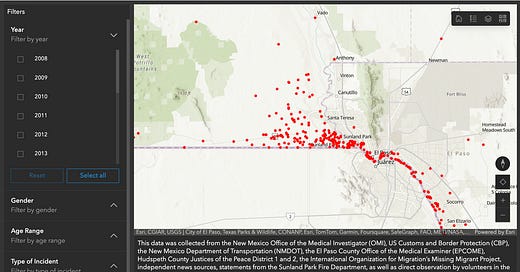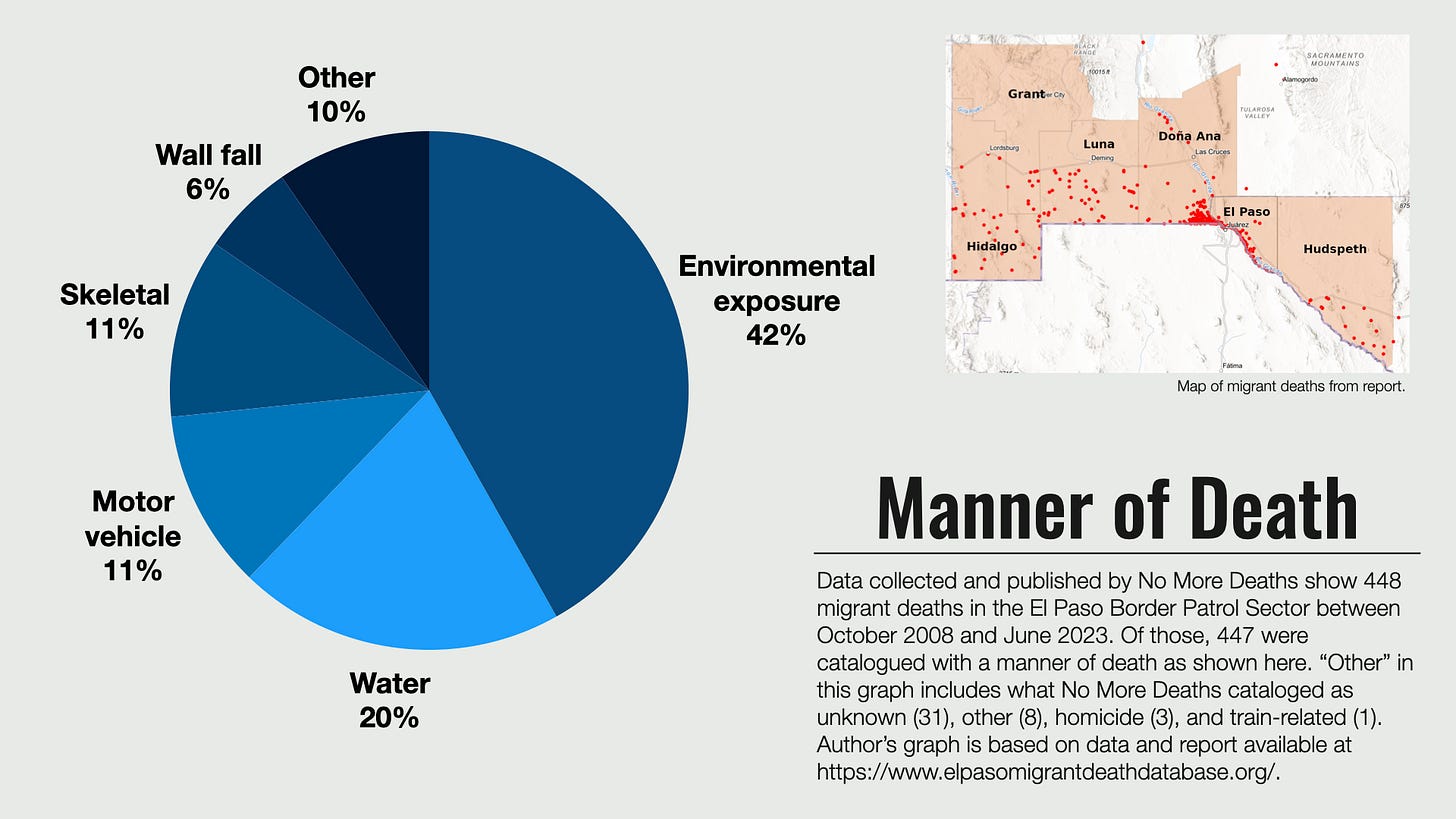15 Years of Data on Migrant Deaths in the El Paso Border Patrol Sector Now Available
No More Deaths (No Mas Muertes) just released 15 years of data on migrant deaths in the EL Paso Sector, adding to our understanding of the human consequences of borders.
Content warning: discussion of death and human remains, but no graphic images or descriptions.
In his latest book, A Case for Open Borders, John Washington says that the best case for rethinking borders is that borders are the source of so much suffering and death.
As if to drive this point home, on the day that I am scheduled to discuss John’s book with him and José Luis Sanz at Red Emma’s Bookstore in Baltimore, the migrant activist group No More Deaths (No Mas Muertes) released an unprecedented 15 years of data on migrant deaths in the El Paso Border Patrol Sector.
Welcome back. My name is Austin Kocher, and I’m a professor who writes about the fascinating world of immigration. If you’re new, welcome! 🙏🏼 You can learn more about this newsletter on the about page. Please consider subscribing.
El Paso Sector Migrant Death Database
The project is called the El Paso Sector Migrant Death Database. No More Deaths describes the data as compiled from multiple sources, including medical examiners, CBP, and direct observation, as well as from the Berlin-based Missing Migrants Project that tracks similar data along routes to the E.U. and elsewhere. (Read more about migrant precarity here.)
The result of No Mas Muertes’ work is an interactive database of what I’m sure were painstakingly validated data points. You can interact with the data through the portal here (also pictured below) or you can download the source data here (kudos to open-source research). A similar interactive database is available at Arizona OpenGIS Initiative for Deceased Migrants.
Two Geographic Observations in the Data
There are two significant geographic observations that stand out to me.
First, “prevention through deterrence”, a border enforcement policy designed to push migrants into remote and therefore more deadly parts of the border has been blamed for many border deaths. Even more deaths happen hidden from sight inside detention centers in Mexico, including the detention center fire that claimed 40 lives last year.
Yet No More Death’s new data shows that, in fact, the urban interface between El Paso and Juarez is the site of many dozens of these deaths, as well. We are no longer hiding migrants’ deaths. Migrants die right in front of commuters on Route 10 which runs along the border through El Paso.
Second, as I was looking at the map, I noticed a concentration of deaths in the Sunland Park area just west of El Paso across the state line into New Mexico.
I remember this area the last time I was in the region. I spent a day driving as close as I could along the border, and ended up driving around a mountain called Mount Cristo Rey which is topped like a Christmas tree with a large cross. On the other side is a set of train tracks and further stretches of the border wall.
I stopped as the sun went down to take a few photographs of Border Patrol agents, the only people I saw in the area that day, including this truck parked at the top of a steep bluff. This is the area, this is where so many migrants have died in the past 15 years—their lives a reflection of years of hemispheric indifference and failed border policies.
“The most convincing case of the urgent need to open borders is that borders kill.” —John Washington
Causes of Migrant Death
No More Deaths’ data also revealed other important insights. Each death is cataloged according to the manner of death. And while many deaths have an unknown cause, most were identifiable. Environmental exposure is the biggest immediate killer and water is second. But then motor vehicle causes, skeletal injuries, and “wall falls” make up other significant numbers of deaths. There are 26 deaths attributed to wall falls in the data.
Making Migrants’ Lives Grievable
Geographer Melissa Wright described migrants as treated as “disposable” by the global economy, and philosopher Judith Butler described certain politically expendable lives as “ungrieveable”.
Migrants whose lives are already invisibilized by our economic and political systems are often invisiblized a second time in death. Projects like this to document the effects of border violence contribute to our understanding of the consequences of borders and aim to make migrants less disposable and more grieveable.
Whatever policy solution one supports—more or less border enforcement, more or fewer walls—No More Deaths illuminates the hidden human cost to our current migration system.
For further reading —>
2024 Immigration Book Round-Up Runs Through This Weekend!
If you haven’t submitted any new books for the 2024 immigration book round-up, be sure to suggest additions in the previous post here and enter to win a free copy of Welcome the Wretched. Contributions will be accepted through this weekend.
Support public scholarship.
Thank you for reading. If you would like to support public scholarship and receive this newsletter in your inbox, please subscribe for free. And if you find this information useful, consider sharing it online or with friends and colleagues.










